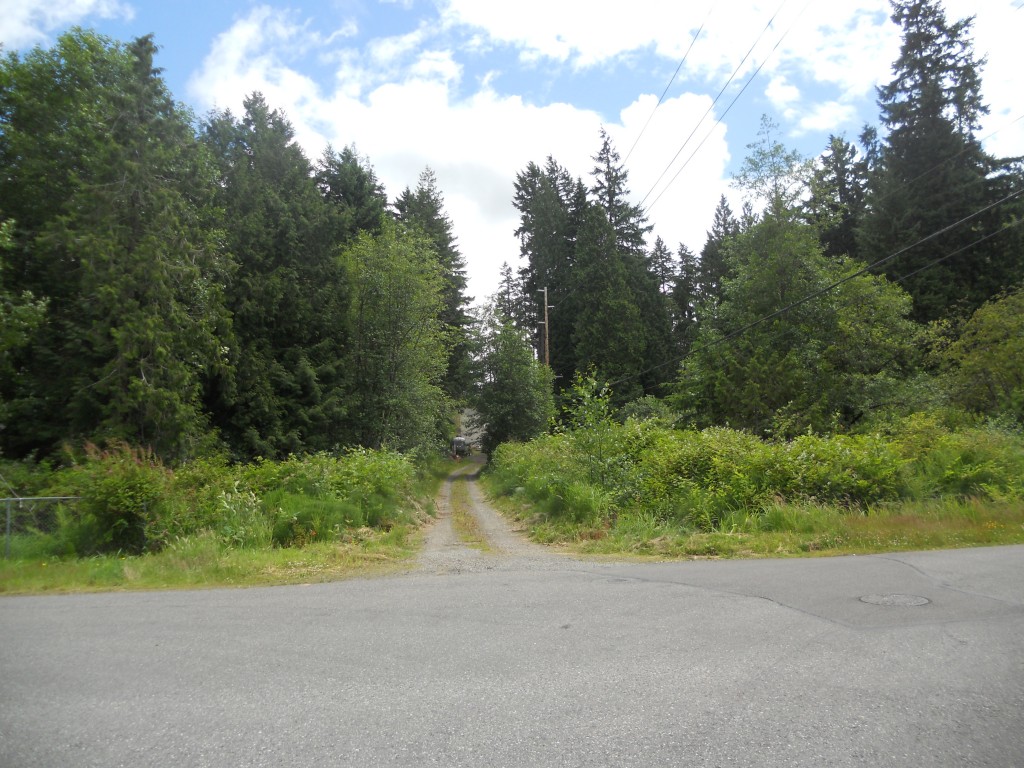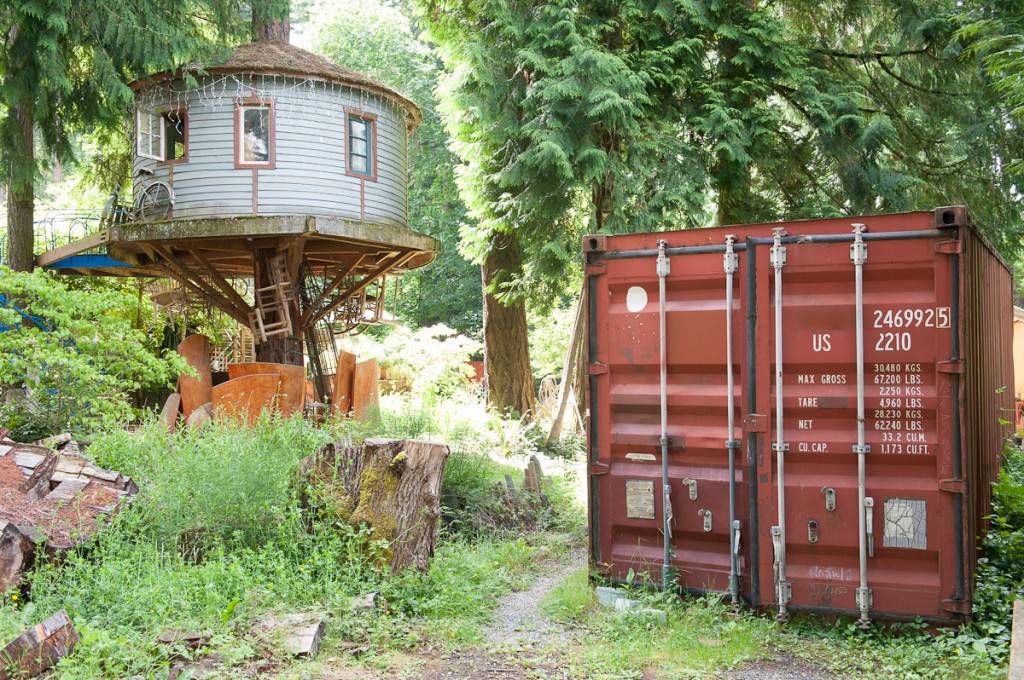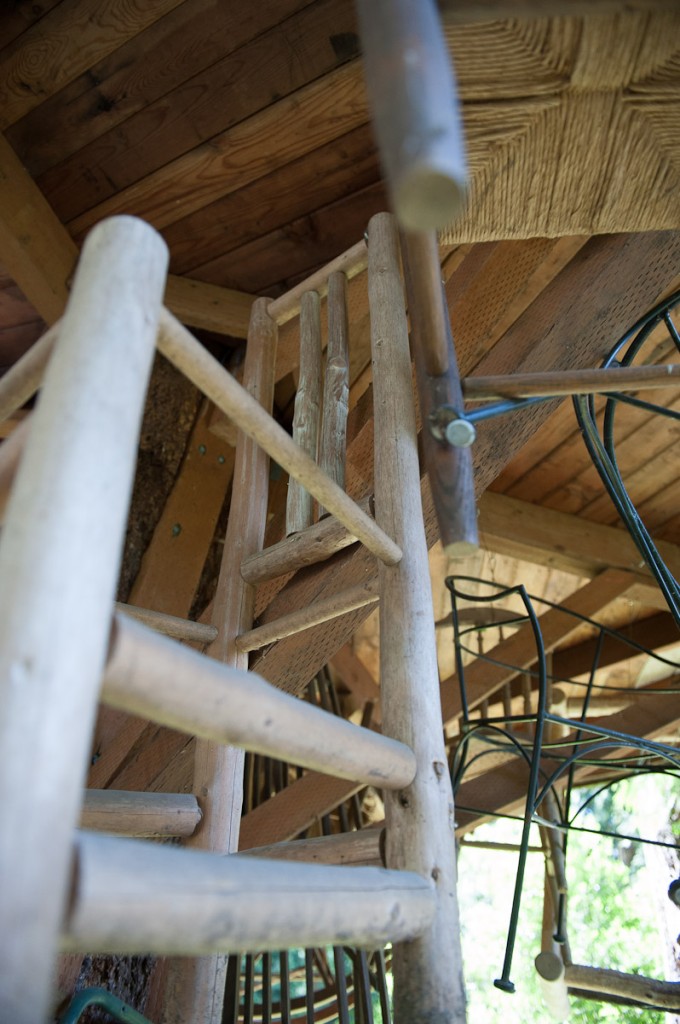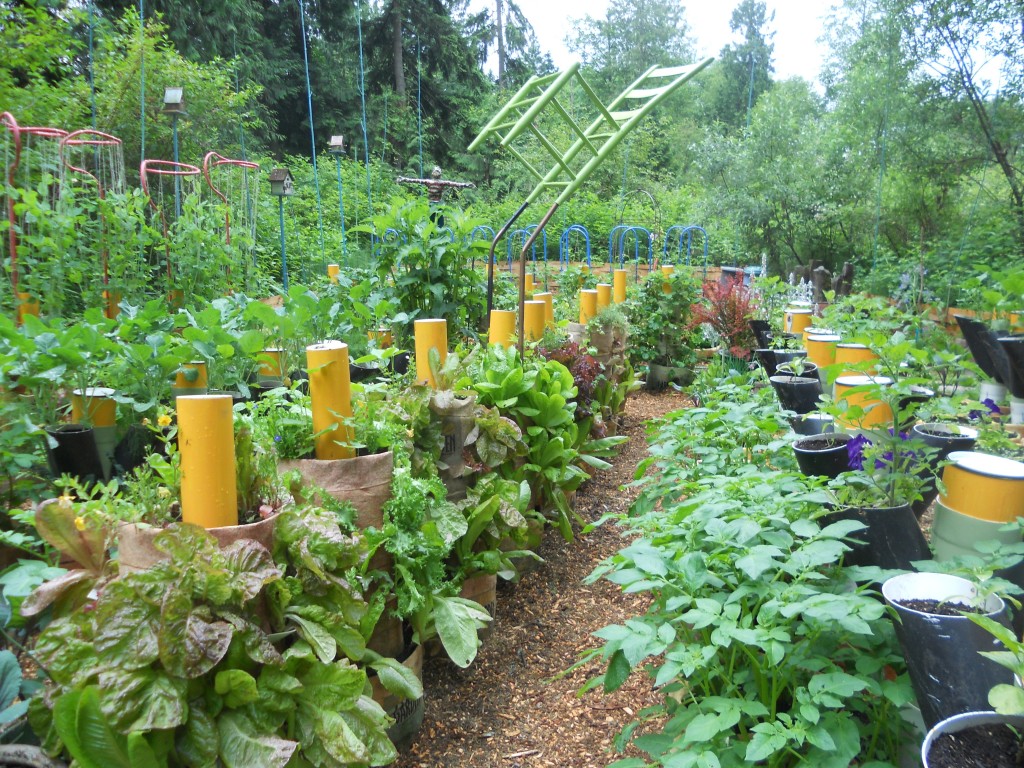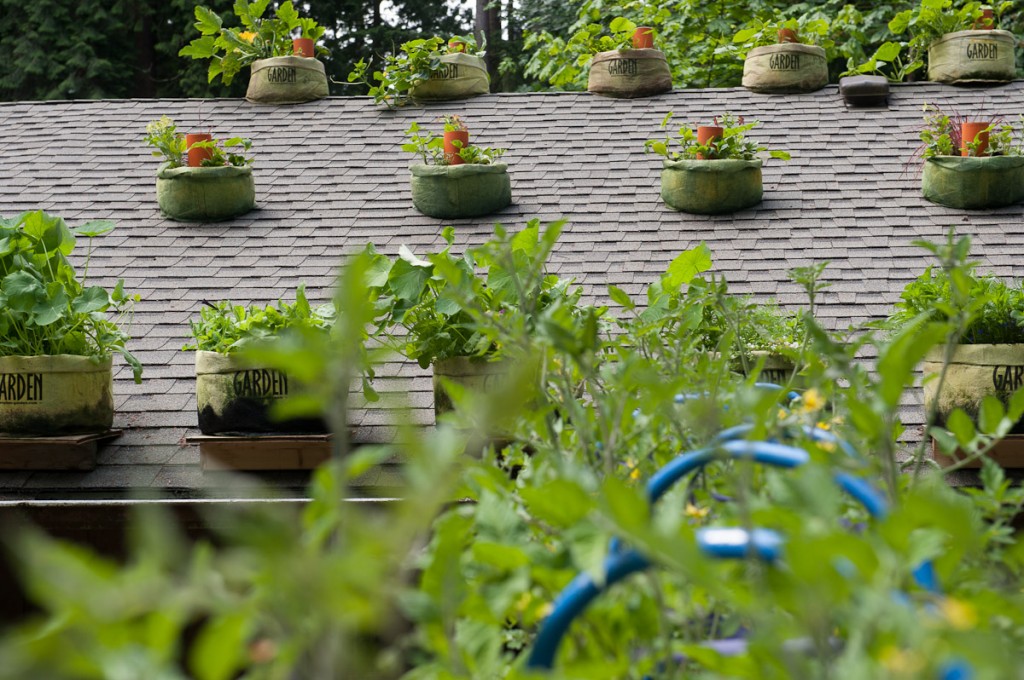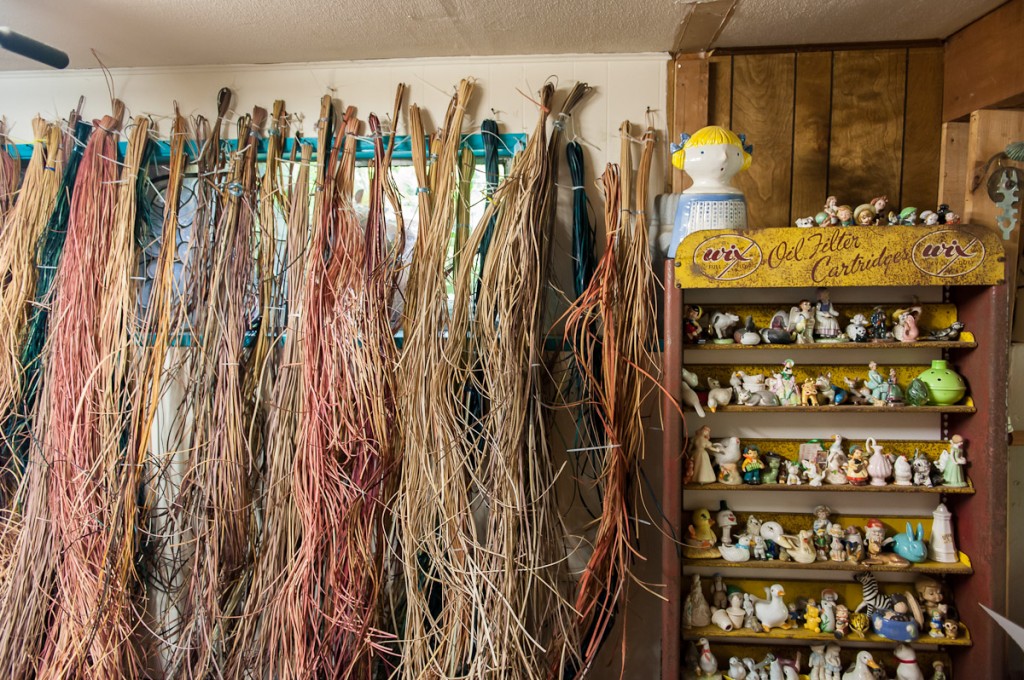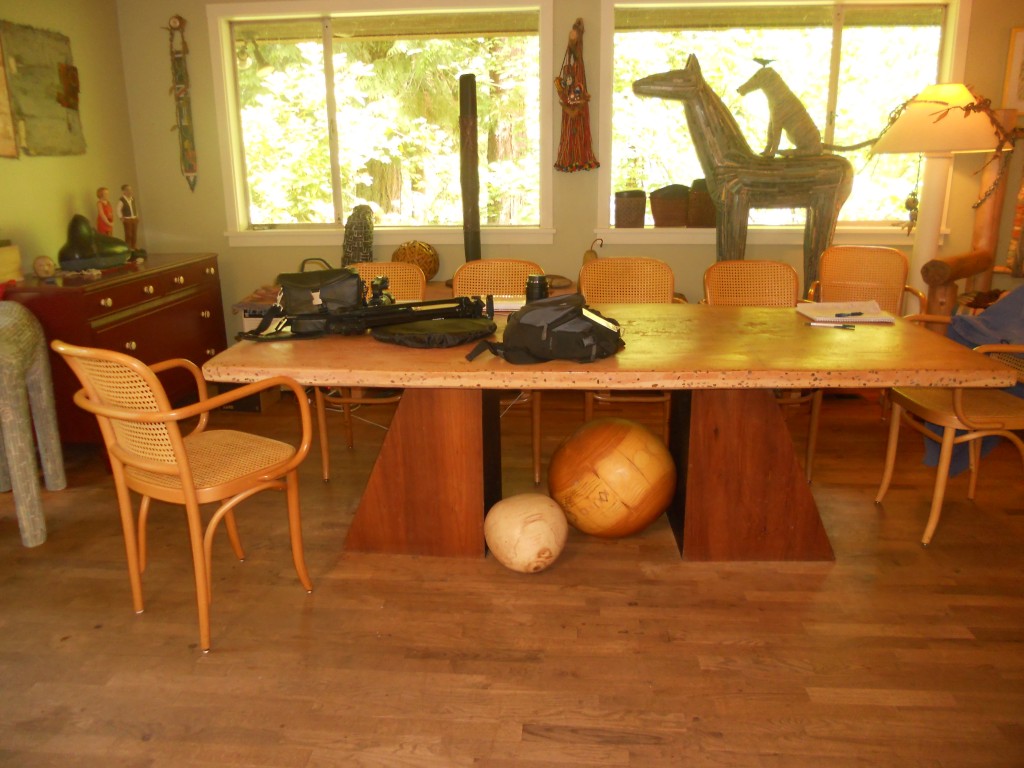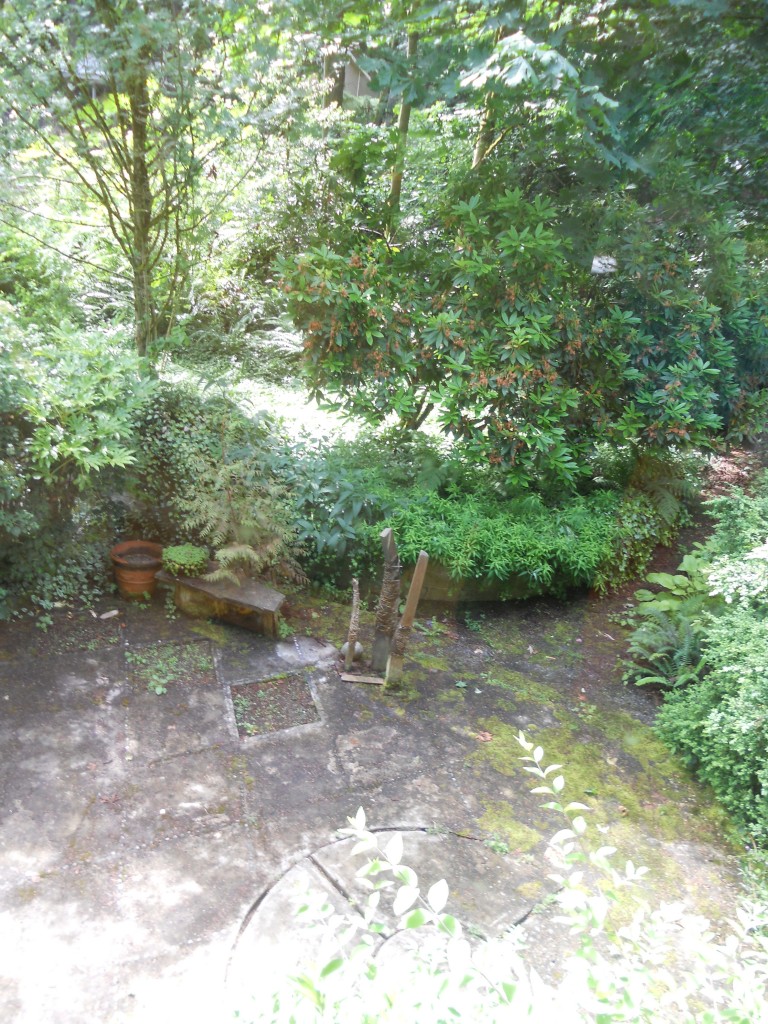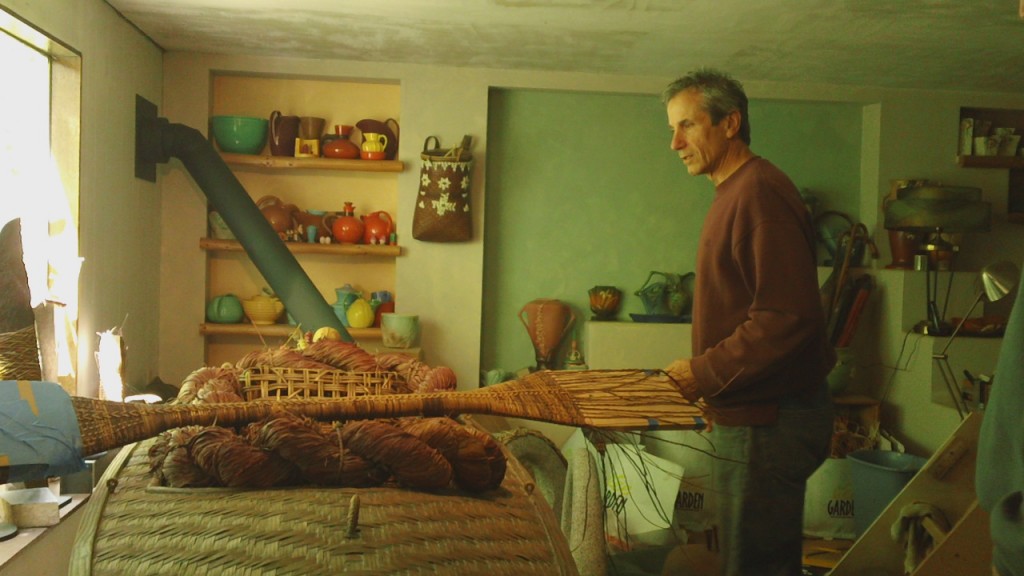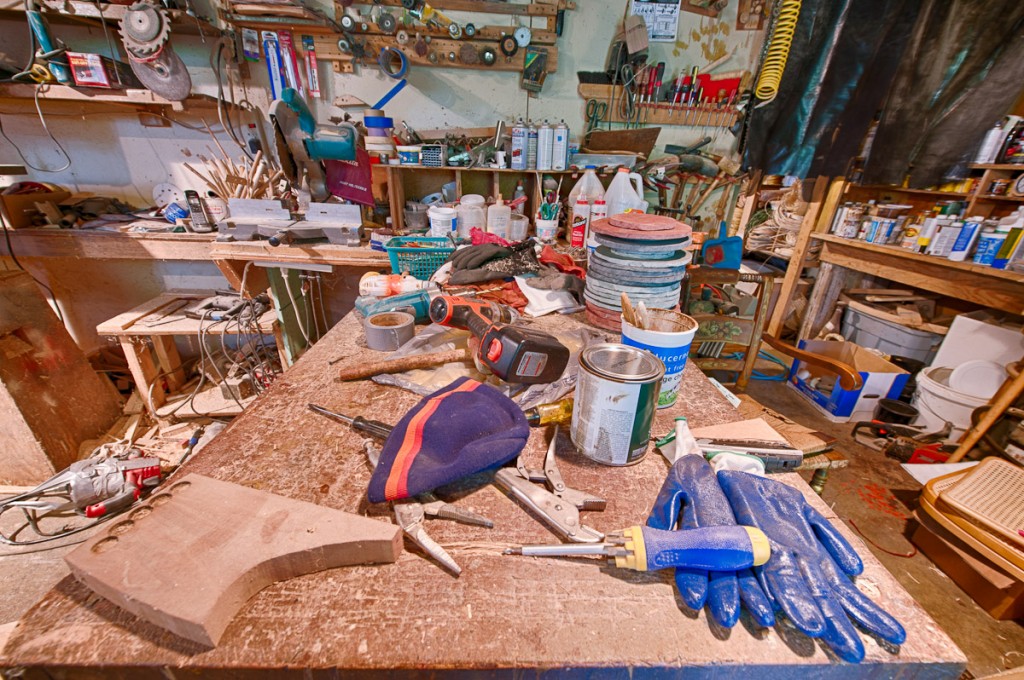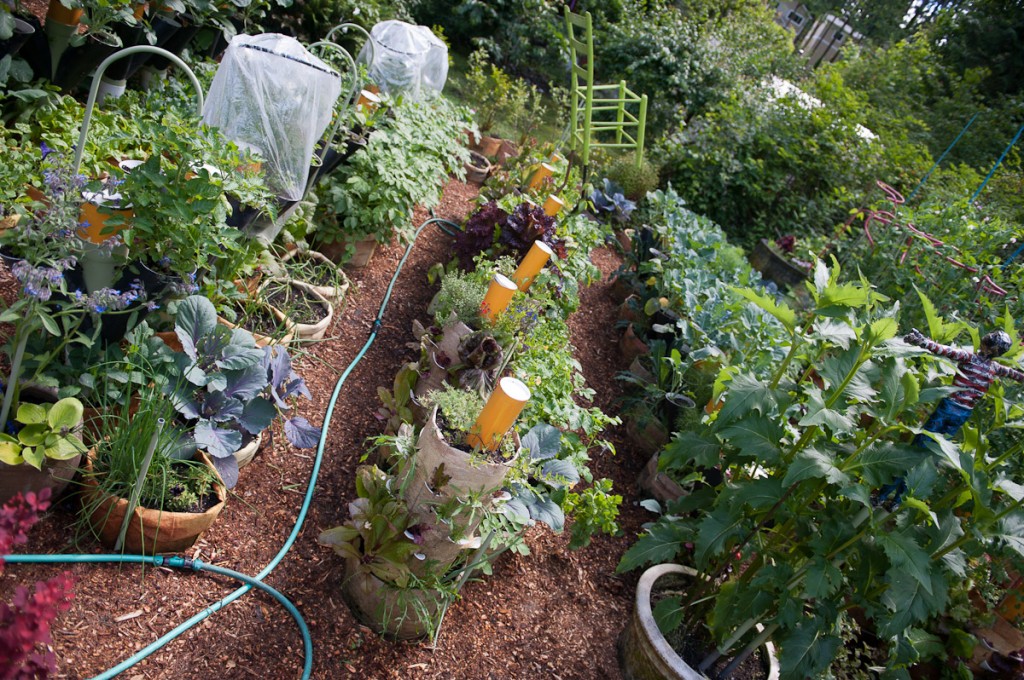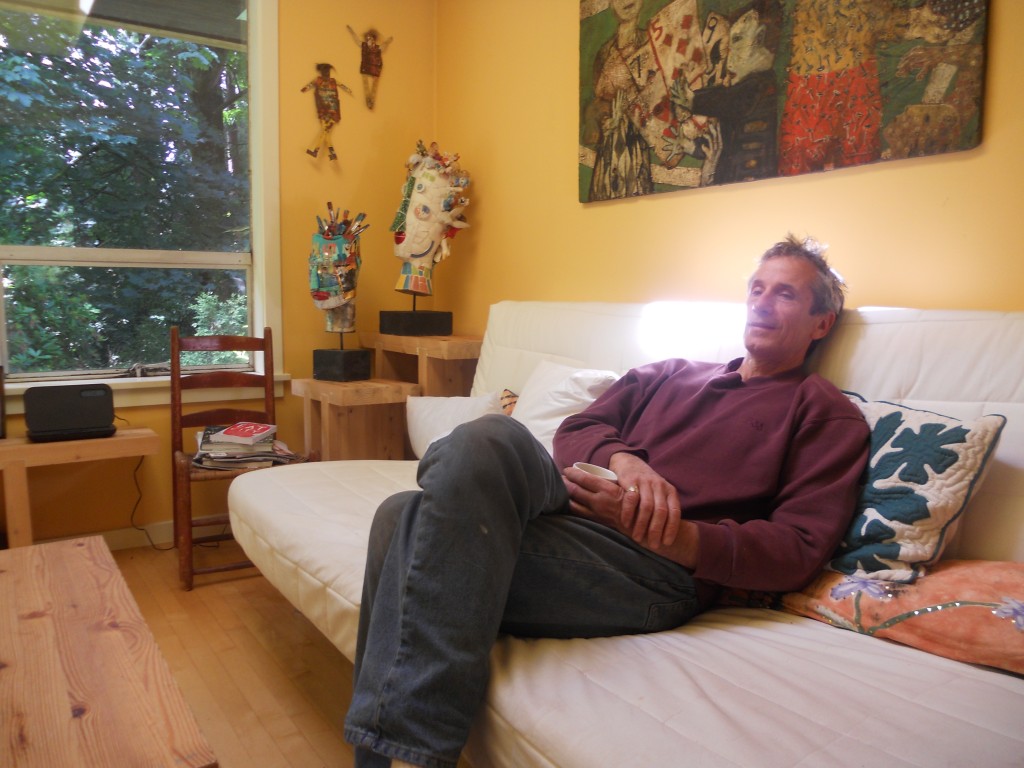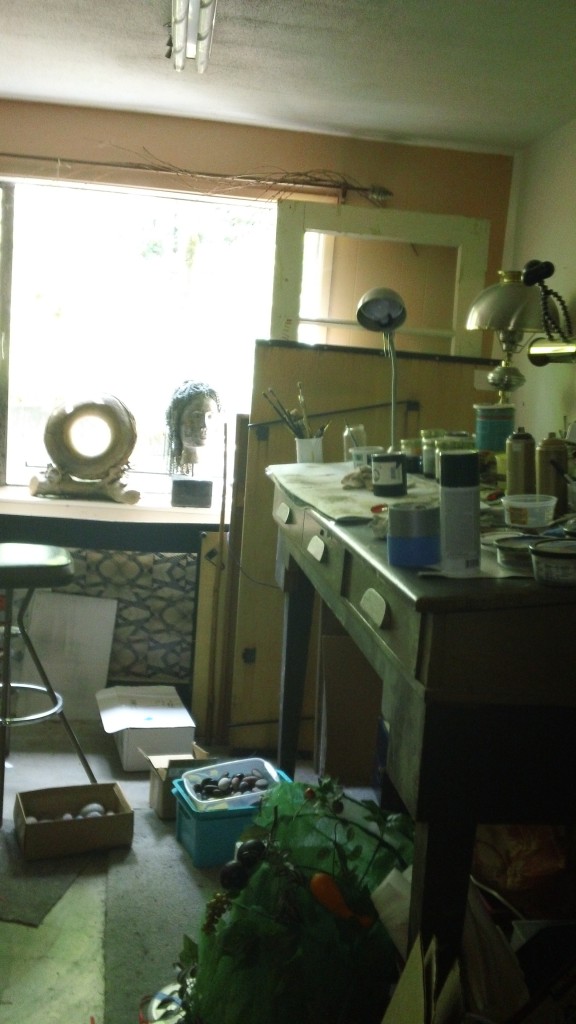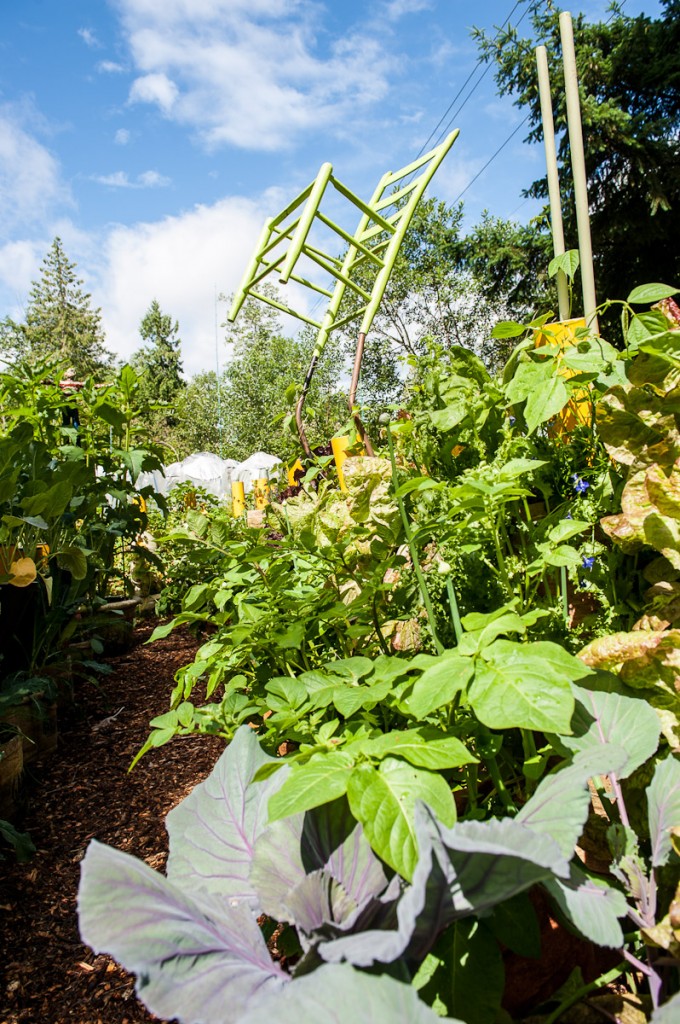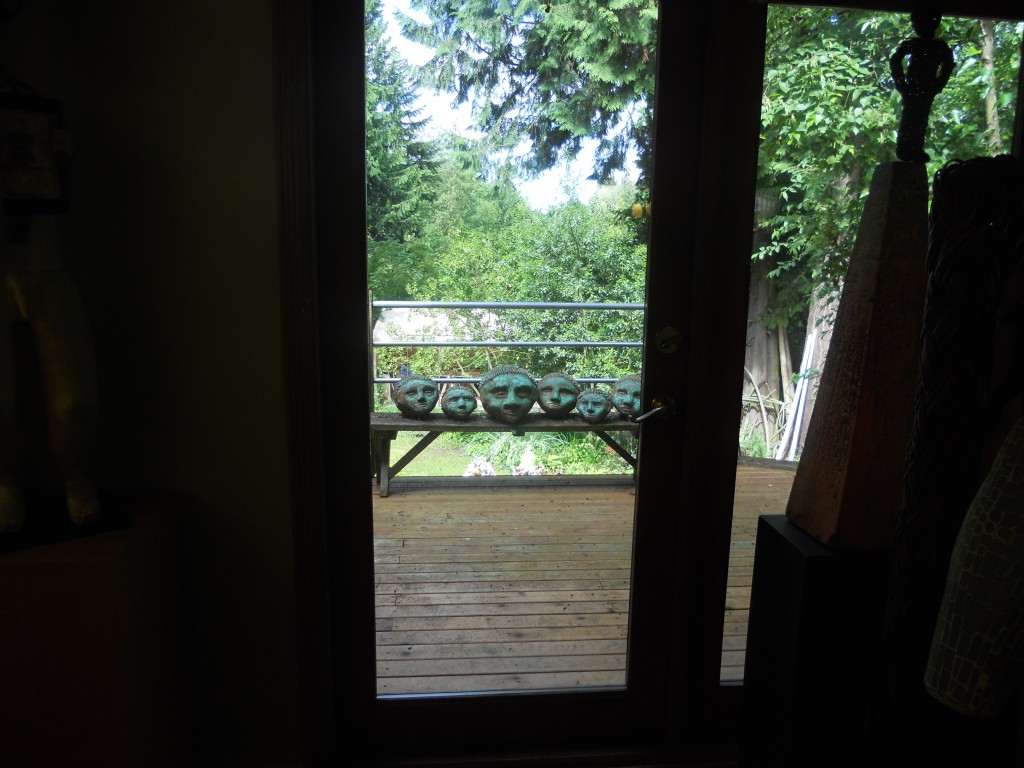I met Del in late June when my friend Erik took me to Del’s home/work space to pick out one of his vertical gardens for my birthday. I was so inspired and comforted by his home/work space that I asked if Daniel and I could come back and hear his story. We decided to swap the story of his self-created, soul-satisfying work space for social media tips from us: a steal of a deal from my perspective.

Kirkland is a suburban town tucked between Redmond (home of Microsoft), Bellevue (home of many remarkably wealthy folks and visitors), and Seattle (home of stellar libraries and universities, less-than-stellar professional sports teams, Starbucks, and Boeing). Most inhabitants are quietly fiesty and outdoorsy people who refuse to let a little rain stop us, bike to work or admire those who do, over-caffinate ourselves, care about community, and distain the use of umbrellas as a tourist thing. Acceptable options for dealing with the rain here include a) just getting wet (humans are waterproof) or b) pulling up the hood on your rain jacket. Kirkland itself has a lovely waterfront on Lake Washington, but its many strip malls and suburban sprall have never made me feel entirely welcome or at home here.
But as you approach Del’s home/work space, a patch of forest rises up–an island adrift in a sea of strip malls, suburban houses, and wide-paved streets. His narrow gravel driveway reads like the first page of a really good murder mystery. What awaits us behind those trees?
As you pull into his yard, the first thing you see is an enormous tree wrapped by a well-built and well-worn round tree house with winding bright blue staircase. The staircase rail appears to be made of wooden chair arms. Then you see a large pile of compost next to a recycled shipping container. We learn later that this is his “warehouse” for the vertical garden kits he creates and sells. Then, an old silver airstream camper.
It’s only as your eyes adjust to the dimmed forest light that you begin to notice the art. Art everywhere. Round wooden balls–as tall as me and several times as wide–casually tossed like marbles around the base of a tree. Chairs hanging like wind-chimes. The longer you stand still, the more you see: stone, wood, and metal sculptures poking out from behind tree branches and tucked into spaces that the forest appears to have created just for them. You can barely see the house through the foliage and can’t see the gardens (what I intentionally came to see the first time) yet at all. More mystery. This is a magic place.
The space makes you deeply curious about its caretaker. Who is this city-forest-dwelling and giant-art-scattering human? As if on cue, Del’s smiling face emerges through the trees–his clothes so seamlessly blending into the woods he lives in that for a moment it seems as if just a floating face is coming to greet you. His walk-out-to-greet-us action reminds me of my farm-dwelling grandmother: coming out of the house to greet us before we even turned off the car engine.
Del gave Daniel and I a tour of the space and then Daniel wandered off to take photos while Del and I sat down to talk.
Lori: How did this come to be your work space? Or what’s the history of this place?
Del: You know, it’s hard to nail down. How you begin working or when do you become an artist? What defines you, it’s pretty ambiguous stuff. But somehow I morphed over time. And probably I have evolved to fill the space rather than me being, the other way around. Often times people are artists, and they have to go look for a space that they can occupy that is the right size for them perform their tasks and create their art in. I think because I have space, and more than a lot, I have had no limits put on me and no walls put up that constrain my opportunity to evolve as an artist and explore other mediums and gather more tools. I just keep expanding. [Del laughs.] And taking over other rooms.
[We both laugh.]
And moving around. I mean at one time there was a family here. And that has changed now so there are empty nest options that we have now. So I guess this is maybe a part of the evolution. The space has opened up so what am I going to do with it? Do I rent it out? Do I just use it for storage? Do I downsize and find a smaller space to live or am I too comfortable here?
Lori: How did you pick this space? What was it about the space originally that made you think? Well, you were telling me earlier that you couldn’t see the house the first time you came onto the property…
Del: Well, yeah, you know, when I bought this place 20 years ago, it was a house in the woods. There are these giant trees around, we’re talking 60 or 70 year old fir and cedar that’s 100 feet, 110, 120 feet tall. And you literally couldn’t see any neighbors. So I felt that I could really enjoy the sense of privacy and also, it was affordable. Because I think nobody else really wanted it because of its isolation. Sometimes that serves us well. Other times, people can feel intimidated by it, less sense of security being all alone. But I kind of embraced it, and have unveiled what I feel was the potential of the place while at the same time unveiling things in my own need, choices I’ve made, because I had the space to work in.
Lori: You said you had the house for 20 years. When you started—and now what you’re doing today as an artist—how much of this were you doing then as opposed to now?
Del: None. Zero.
Lori: None?
Del: I started making art in, let’s see. I bought the place in 1991. I started tinkering around the fringes of art in about 1998 or 99.
Lori: You’re kidding! This place. Wow. It feels as if an artist has lived here for 100 years!
Del: Well, this is just the way I attack.
[Lori laughs]
Del: You know, when you’ve got long days, and you love what you do.
Lori: Yeah.
Del: It isn’t a 40-hour week. It’s a lifestyle.
Lori: Yep.
Del: And so you move into it. I think that what I’ve learned over time is that some people buy a home and they always think of it as this precious vessel that needs to be maintained and preserved because when they sell it it has to be in a certain condition for the marketplace. Whereas I’ve always taken it upon myself, or taken it upon my home, the assumption that it’s all about me.
[We both laugh.]
Lori: Yeah.
Del: And what their needs are, or the marketplace, or whatever. It’s all about what makes me comfortable, what makes me happy, what makes me feel like it represents and expresses who I am. And if people come here, if I weren’t here, people will know who I am.
Lori: Absolutely they would.
Del: And I think you can walk into many homes and you never get a sense of really who the person is that occupies that home, except it looks as if they have good taste, maybe. Or they have a sense of color. Beyond that, nobody’s going to put a nail in the wall, alter the space to dramatically, for fear of damaging their investment. I think I’ve always, kind of, gone the other way. [Del laughs.]
Which, as I grow older, you know, I think to myself “Maybe I’m digging this hole a little too deep to climb out?!” [Del laughs.]
Lori: No, I don’t think so. I don’t think so. I don’t know. There’s something about a place that feels loved that I think comes through in a way that. Because I’ve kind of had to grow into that myself. I think when I was 30, maybe, I was more along the lines of, ah. It’s almost like you’re making a space to represent what you think other people would want to see.
Del: Exactly.
Lori: As opposed to making a space in which you truly feel deeply happy. Part of that, for me, was leaving Microsoft a number of years ago and just deciding to do what I love. But now, yeah! It really is about I want to LOVE my office. And I want to love. And now that I’ve turned it into a coworking space, I want to love that entire floor of my house.
Del: And because you are about community that is your bridge to community. It is an invitation to community. A way that you participate in community even without a community. [Lori laughs.]
Lori: Yeah.
Del: Kind of contrary to that. Often people who live in a community try very hard not to do anything in their space that would offend the community. And so they exercise a personal restraint for fear of intruding on their neighbors by the appearances that they have their own preferences about. Whereas I don’t have to worry about that because I’ve got a property here that creates a nice buffer for me. This shielding of trees and foliage and things that protect my neighbors from me. [Lori laughs] Which is kind of a good thing. Also, when I bought the property 20 years ago, at that time, property had very little value. Now, when I look at my assessment, the house has no value, it’s all about the property. It has flipped because there is a finite amount of property available as populations have grown up.
Lori: Oh! A big branch just fell!
Del: Yes, and there’s that.
[We both laugh.]
Lori: It’s really windy today. When we came across the bridge there were big white caps. You feel really protected from that down in here.
Del: I’m in a bowl, which creates a certain kind of protection. I have a lot of big trees that are knit together with their root systems, which is kind of nice. But, if anything goes wrong, it goes wrong really bad. If any of these big trees come down. They’re just a giant people swatter.
Lori: Will you describe the work that you do here? You’ve shown me the rooms…
Del: Well, I think of myself as three distinctly different businesses. The art, mostly sculpture. And I work in quite a few different mediums within that category of art I’m three or four different artists. But then I also have a furniture repair and restoration business, which is unique because it also relates to the fibers that I use for art. So I’m a specialist in certain fiber repair in furniture, so I have a niche in that marketplace that really is my bread and butter. And then the art kicks in and it’s grown over the years, in income, to almost equal to that, so I have two jobs with two revenue streams there.
And in the past few years I’ve started developing this garden idea, which is a gardening system that I like to call a “kit of parts.” It’s become a passion of mine along with the art and the furniture. It’s a bit more seasonal, but as a business, an entrepreneurial adventure, it’s more all-consuming because it’s about manufacturing and marketing as opposed to the art, which is kind of one of those things I backed into, almost. And I guess I’ve just been really fortunate in people encouraging me, and being supportive. I haven’t had to work at all in finding a marketplace for the art. But the Vee Garden idea is forcing me into a whole other growth spurt. Where I have to learn a lot more about the modern business acumen and landscape than I ever had to do before.
[We both laugh.]
And not having been a student for, you know, 40 years, it’s hard. Finding that new gear. It’s a challenge. But I’m enjoying it and hopefully it won’t break me. We’ll see what happens with it.
Lori: What do you think this space—your whole property or the particular spaces you work in—what does the space give to you? And what have you given to the space? By the way, I’m guinea-pigging you on these questions. I may not ask everybody these questions. We’re just starting this process. But I think an artist can handle that question.
Del: It’s a good question, because I often reflect on the idea that having space affords me opportunities that a lot of people don’t have. Having space, and having different types of spaces, it’s like having different microclimates that provide you with a unique opportunity or stimulate your creativity as to how you can use this space. A portion of your space has a very different light or personality. So it’s about allowing me growth, evolution, that when you work in a small studio you maybe can’t think outside of that envelope. You think within the structure that you’re given. So the scale of the work that you do is dictated by the scale of your space. Where you have unlimited space [Del laughs], unlimited potential.
But then it comes down to trying to exercise discipline. How do I grow into this space? How will it serve me? And is it practical? Because most artists would probably attest to the fact that we’re spontaneous and passionate about something [We both laugh.] without really giving it the kind of forethought necessary, to think things through, to “Oh my God? What have I done?!” [Lori laughs] ”I’ve got to commit to this. And now I’ve bought all these tools and things, but really, is there a market for this?” or how am I going to continue to use these things in a way that pays for them and makes it useful? It requires a little bit of strategic planning and forethought to grow. When you have the opportunity to manage that growth you have to make sure that you back up and maintain those spaces in a way that makes sense.
Lori: Speaking of good light. I’m going to take a picture of you while I have sunshine. There’s so little sunshine in the Northwest. I fear that our web site’s going to be dark. [Lori laughs.] Dark photos.
Del: Isn’t that great about this room right here? It was all about the light and color.
Lori: Yeah.
Del: And I knew that. Having bought this place tucked back in the trees and really, for that matter, when that was all treed out there, up until 10 years ago, this was done [pointing at the skylights] before those trees were moved because this was my window on the sky, a little opportunity for a shaft of light to come in here at a certain time of day if the sun was out. I wanted to be sure that it completely permeated everything.
Lori: You’ve discovered. We almost kind of need the color yellow here in the Northwest. We know an architect who is, ah, you know, sort of snooty about. People who say the only color that a wall should ever be is white, black, or gray. And I’ve thought, our upstairs, we have a lot of white. But I needed yellow downstairs. Because white, in Seattle, plays as gray a lot of the year. And white just does not cut it here in a way that white on a wall will cut it in Los Angeles. [Lori laughs] I needed yellow in the living room. It’s almost like yellow is a white here. The white we need to not be gray all the time.
Del: It’s a warmth, too. Psychologically it’s uplifting because it reminds us of what the sun might be. But I think that even subliminally there is a context of a warmer place. We’re transported a little bit of what yellow represents. It means something different, deep down inside. Maybe there’s even something primal about it, that we find in our cave.
Lori: The experience of this being a good space for an artist wasn’t lost on me when I was here with Erik, because Erik has always lived in a small space. And he’s got so much creative potential. My house is full of pieces of his art. But he’s always lived in such a small space and the more we walked around your space, the more I thought to myself “Man, if Erik had a space like this!” [Lori laughs]. Because this is what Erik would do to the space. His little space looks like your space. There’s art everywhere! Every square inch has got art on it, and every surface is an art making surface. But there’s definitely a constraint.
Del: Why don’t I get to see Erik’s art? Do you think he lacks confidence? Because you’re a big supporter of his. If you were to stand back, and look at his work, do you think it just lacks an audience?
Lori: I think that. Well, my own personal opinion on the subject, which might be completely wrong, is that I think he’s spent too much time with people who care too much about whether or not there’s an audience for it. He’s spent his entire career working in high-end galleries. And I think there is a big benefit to being an artist in the non-practical side. The “I’m going to make something that I love.” I think he’s spent a lot of years trying to make things for the marketplace as opposed to from a place of love. And I’ve seen him be more. Since his father got cancer a couple of years ago, and passed away, I’ve seen him make a lot more stuff for himself, recently. Things that remind him of his father. And I think that that has helped him. I think he has needed more artist friends and less business people friends.
Del: Right, right. Listen. You’ve hit on a very important point about art. Not just as a market, a medium, a performance. But also as a form of therapy, and introspection, and a way of kind of finding out who we are. That opportunity for personal growth, not exclusive of.
[A loud knock on the door is heard.]
Del: Come in! Could it be Daniel?
Lori: I don’t think it would be Daniel. He wouldn’t knock.
[A furniture restoration client of Del’s shows up, they talk shop for a few minutes, and he leaves.]
Del: I’ve known him since he was a kid. And I’d been doing business 20 years at that point. So it’s people who know me. I’ve never advertised that business just grew, had a niche. Nobody else did the stuff that I was doing. It’s just been word of mouth. And that’s what it’s all about. I think of this whole new enterprise of the Vee Gardens. So where were we?
Lori: I’ll ask you just one or two more questions. I want to be cognizant of your time.
Del: I can be a bit long winded.
Lori: That’s awesome. The more long-winded the better. I’m having to transform into my role as community story wrangler, is my latest title for myself.
Del: I like that.
Lori: As a qualitative researcher, I would go in and spend days of time with people. Listening. Then I’d get it all transcribed out off of the audio files, and I’d have this much [holding hands two feet apart] story to wade through. I’ve moved from that to trying to tell stories every month on a web site so, yeah. But I love long-winded. The more long-winded you want to be the better. But I want to leave us time to talk social media, since I know you have to leave at noon. So I’ll ask just two more questions.
Lori: I guess a good one would be. A lot of people who will be hitting our web site are people who are unhappy with their work, considering leaving their work, or thinking about creating their own work spaces. Do you have tips for people in the pursuit of creating your own space to work in?
Del: Wow. You know, I think it’s not a tip. Not really sure what I would call this. But what I’ve learned about myself, and in our discussion about Erik, is that choices are our voice, and everything’s a risk. When you’re an artist, unless you’re really very arrogant about what you’re doing, you’re going to be vulnerable. You’re going to be taking risks.
Sometimes you can do it with some variables of caution. And I would say that for all of my enterprises, they have been transitional. I’ve always had my foot on two different steps. I’ve always had one hand on a vine before I let go to grab another one. And I think that for any adventure, any new potential that needs to be explored, a sense of security is important, but also I think you’re going to have a certain leap of faith too. And it will come from some soul-searching and building the confidence in your own abilities. And a vision for where you want to go without too much frivolous spontaneity. With some forethought, a little planning.
But you can always plan something to death. To the point that you never get started. This is the same thing that I’m addressing right now in terms of gardening. And how, it’s interesting–real quickly as an aside…
Gardening has gone through all these different evolutions. Hard to get started. You have this giant yard that you have to dig up. Back in the 80s, this guy had a great idea for how to get people focused down to a smaller scale, called the square-foot gardening method.
Lori: I read that book at some point!
Del: So people thought, “Wait, all I have to think about is this square foot and then I can extrapolate.” it’s expandable, contractible It was scalable to my space. A way that people could relate to something so it didn’t feel so intimidating, abstract and monolithic. It could just be this much. And grow with the space. I think that that is a great model for applying your energy when you’re focusing in a direction with just about anything. Start with something small that you can get your arms around, and then expand on it where there’s potential given a certain degree of success with this first, tiny step. Then it can be something bigger if you choose to make it be.
Lori: You’re making me think of my own yard and how overwhelming it was when we first moved in. For the city it’s a pretty good sized space and it was a complete disaster, complete disaster. Like piles of garbage in the back yard, bicycle tires hanging in the tree. [Del laughs.] The house had been a halfway house for recovering crack addicts.
Del: Wow.
Lori: The people had come in and fixed up the house but had done almost nothing to the yard. You used the word microclimates before. That’s kind of how, over the years, I had to approach the yard because it was so overwhelming. So it was “Ok, there’s this patch that’s 5 feet by 4 feet and it’s sunny and against the side of the house, I’m going to garden THAT this year. Figure out that.” And it was almost like little microclimates, because I couldn’t even get my head around doing the whole thing. I see a space the size of your lot and I think “Oh my goodness!” [We laugh together.] That’s an impressive amount of area you have to attempt to think about gardening.
Del: Well, there’s a lot that gets neglect.
Lori: Or, nature takes care of it.
Del: Or nature takes care of it. Exactly! And I think that’s a very good sort of way to think. The things that I don’t do are just as good and productive as the things that I do do.
Lori: Yes.
Del: What I don’t do is left to nature, that habitat, that biodiversity, that quality that actually adds to the quality of life around the things that I do do.
Lori: The spots in my yard that are gardened without worry are the spots that nature does. We’ve got a spot in our yard where a few feet under the soil is a huge old cedar tree. Above that cedar tree every spring all these beautiful ferns come up. They come up in the spring and last into fall. So it’s kind of an ugly spot during the winter. But it’s the most beautiful part of our yard for 8 months.
Del: Lush greenery.
Lori: Completely covered with amazing ferns. It’s no work at all. And people always come—because I’ve gardened the rest of the yard—and people always come in and say “Oh that spot is so lovely!” and I get to say “That is the part I didn’t do!”
[We laugh together.]
Del: Sometimes, it’s knowing what not to do. Or when to stop.
Lori: We made a decision when we first moved in, because we were having the backyard dug up and flattened out in parts. We made a decision to leave that dead tree under the ground. We’re so glad we did. I don’t know how many more years of amazing ferns we’re going to get from that dying tree.
Del: It’ll go forever. Our lifetime probably. I’ve got those around out here. Those underground nursery logs they just last forever.
Lori: Yeah.
[Daniel walks in.]
Lori: Hi! How’s it going?
Daniel: Hi! Good, how are you?
Lori: We were just talking about
Del: Ferns.
Lori: The ferns in our back yard and how, ah, taking, ah.
Del: And how hard you don’t have to work. [Del laughs.]
Lori: How hard you don’t have to work. The best parts of your yard are often not the parts you did anything to.
Del: But you know, on the other side, how do you really manage, or capture, or make use of anything that seems overwhelming? And I think it comes down to that idea of how you begin anything. It’s about taking a deep breath. It takes as long as it takes. And I just have to do this one thing first. Just get your head into it.
And make it almost a Zen experience. Not thinking of it as work. It’s about becoming immersed in a mindless task. Sometimes.
Lori: Yes. Mmm, hmm.
Del: And it is, in itself, an escape. And fulfilling, just in the process. To get it to where you want it. So then you can do with it what you want to do. Sometimes that, to me, is as fulfilling as anything.
Lori: Yes.
Del: And just getting organized. Though I look totally disorganized all the time! [Lori laughs.] It’s not about that. It’s about how do I tame this? How do I begin and manage and construct a starting place?
Lori: I love hearing about different people’s ways of getting to that. Making it feel Zen. Making it feel good. Because it’s so different from person to person. I know when I was here last time and I described to you turning my house into a coworking space and inviting strangers in every week to work you were like “Bleh! Ugh!” [We laugh together.] But that’s what I need to feel Zen in my space.
Del: Everybody has a different way of doing it.
Lori: I don’t fully get to that Zen space as an individual. I do certain days a week. And other days I need that interaction with other people.
Del: Yeah, you know, I was once married to a woman who aspired to be an artist. But she felt that she had to have a studio somewhere else to go to. And that was a trigger for her to be able to begin to work or to formulate a discipline for working and productivity. She needed a separation of that work ethic from her living style. I’m totally the opposite. That’s probably just one of the reasons we didn’t work out. [We laugh together.] But, it’s more, to me, about every fiber of my being, every minute of every day.
Lori: Yes.
Del: Being about my focus, my energy, and then really tapping into that.
Lori: Me too. Me too!
Del: And putting that into and aspiring to the greatest potential that that can give me, as opposed to separating and walling off and pigeon-holing each of those different components of your life. As being something extraneous at one moment and then all-consuming at another. It’s about all of it being integrated. Homogenous in a way that as I’m walking to the garden, I’m looking at the sculptures I’ve got going, or the stone work I’ve got going, and thinking about when I’m going to get to that and what I want to do next. And as I’m walking back to the house I’m pulling weeds. [Del laughs.]
Lori: Yep, yep, yep.
Del: And doing all those types of things. It’s always about—no matter what I’m doing—I’m in the process of living my life, which some people call work. [Del laughs.]
Lori: Exactly, exactly. I had to run from Microsoft the last year I was there because, for me, I could not stand the phrase work/life balance. I was like “It’s integration!” It’s “My work is my life” and it’s not separated. And I don’t want it separated. And I don’t want to have to shut a door and forget my work to be able to live my life. I just couldn’t.
Del: I think that is the plight of our modern culture. That we have so many hours that we dedicate to work so that we can go home and put our feet up. We have so many days of work that we have to put in for our weekend. And then so many weeks of work to earn a vacation. And so many years of work to retire. And it’s always about, kind of like, work is what you have to do to get what you want. As opposed to all of it being more integrated.
And then when you get what you want, it’s almost such a foreign thing to you, you’re overwhelmed by it and you die.
[We giggle like little girls together.]
Del: Or you haven’t quite gotten it organized because you never really did commit completely to it because you never had the time.
Lori: Yeah.
[We become quieter, saddened at the truth behind this thought for so many.]
Del: And then you retire and it’s like “Oh my God. Now I’m just going to eat bon bons and watch TV because I don’t have the personal discipline or motivation to apply myself to something that’s really going to be healthy for me.”
Lori: When you talked about following your energy. Now that I’ve been able to work for a number of years in a space where I can completely follow my own energy, that old way seems so inefficient to me.
Del: Oh yeah.
Lori: It seems so inefficient to say “Ok, I’m going to do work between the hours of 9 and 5.” When really, if you were able to follow your own energy, you can get a LOT done. Now I’m energetic about the garden. Now I’m energetic about the. Ok, sometimes I’m maybe too scattered about all the different things I’m doing but.
Del: I think energy, like in gardening in microclimates, has its ebbs and flows. You can have the right sort of mental energy to accomplish a heck of a lot more at one time of the day when your blood sugar or biochemistry is better suited for that task. Other times of the day, pure physical work because you’re not quite getting the focus. Things aren’t going the right way. I think that a day, a life, can have a lot of different energy. I mean depression, exhilaration, you know, and if you try to fight against that tide you can be counter-productive. You can probably, in fact, I’m sure, it’s more likely that you’re going to make mistakes, and undo potential productive effort because you’re forcing yourself to do something that you’re not really in that moment acclimated to.
Lori: Yeah. Well, I think that’s my questions for you. And I want to give ample time to you to talk social media so.
Del: Well, you know, just talking with you two and hearing about things like…
[End of this particular discussion. Beginning of another one.]
Thank you, Del, for sharing your story, space, and self.

